
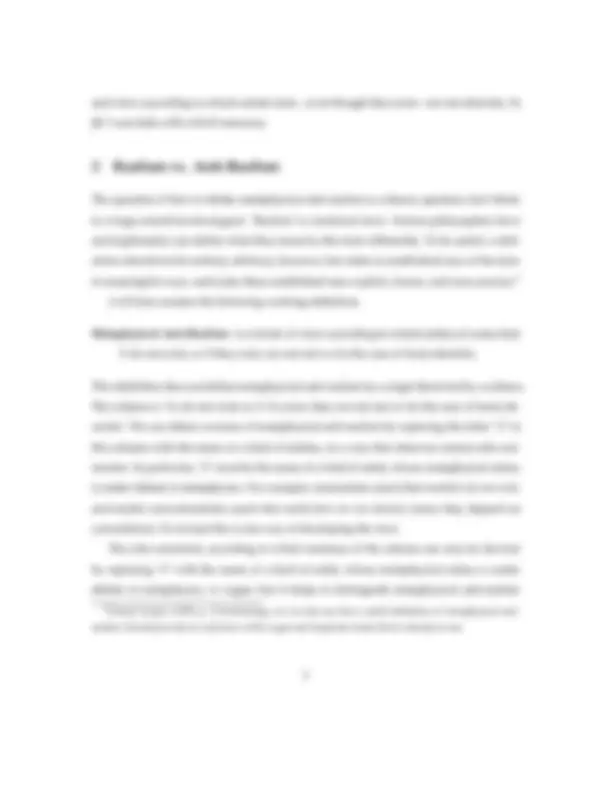
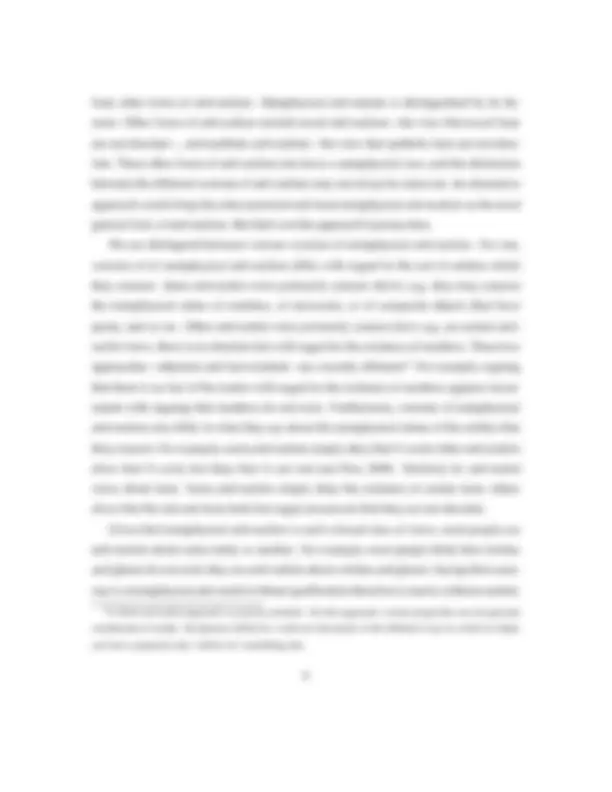
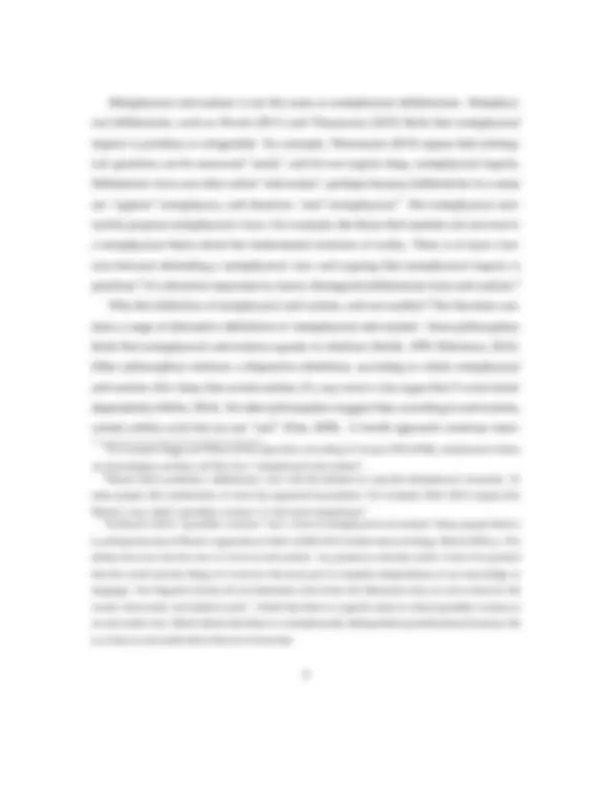
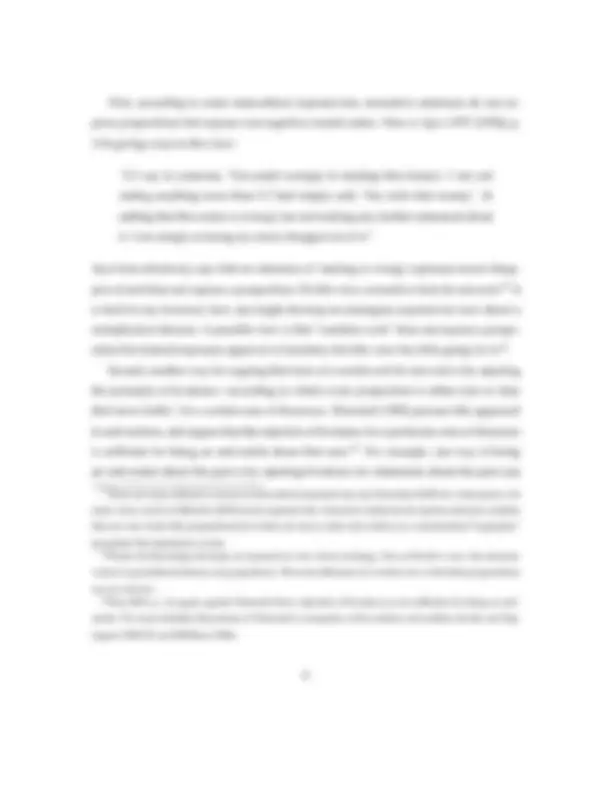
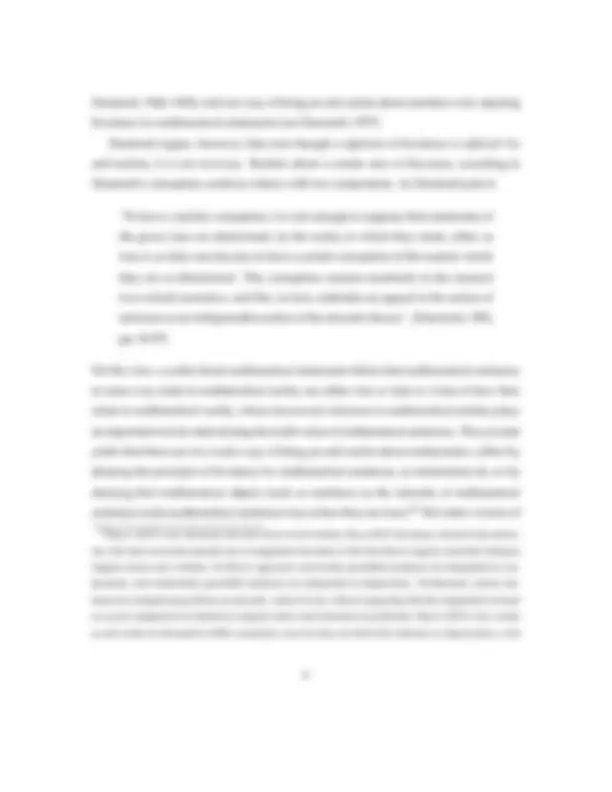
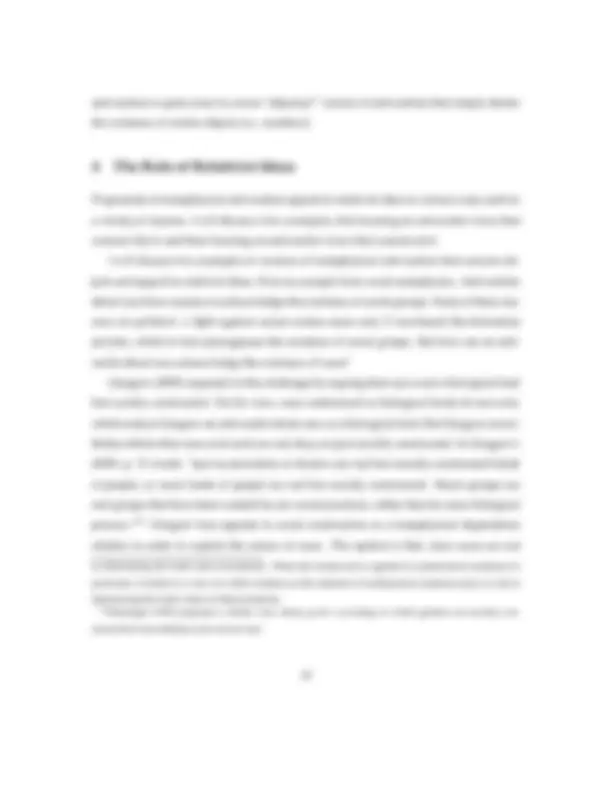
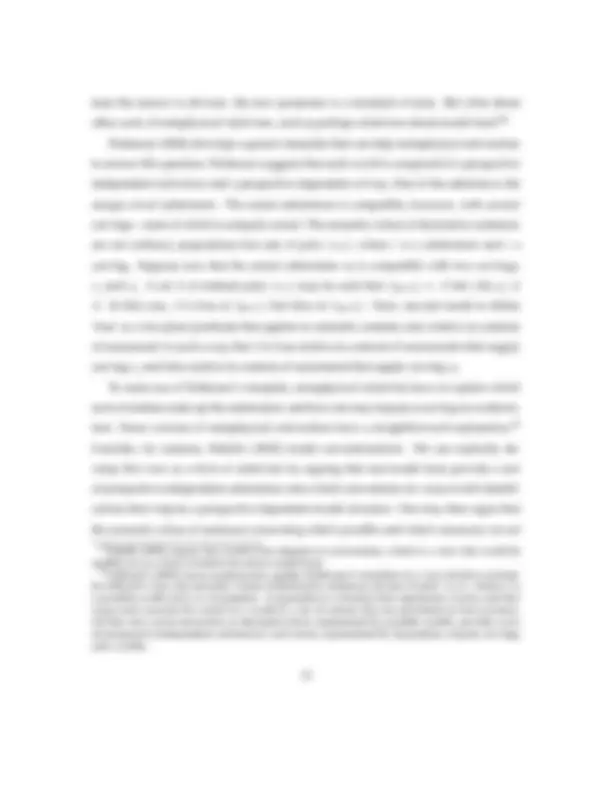
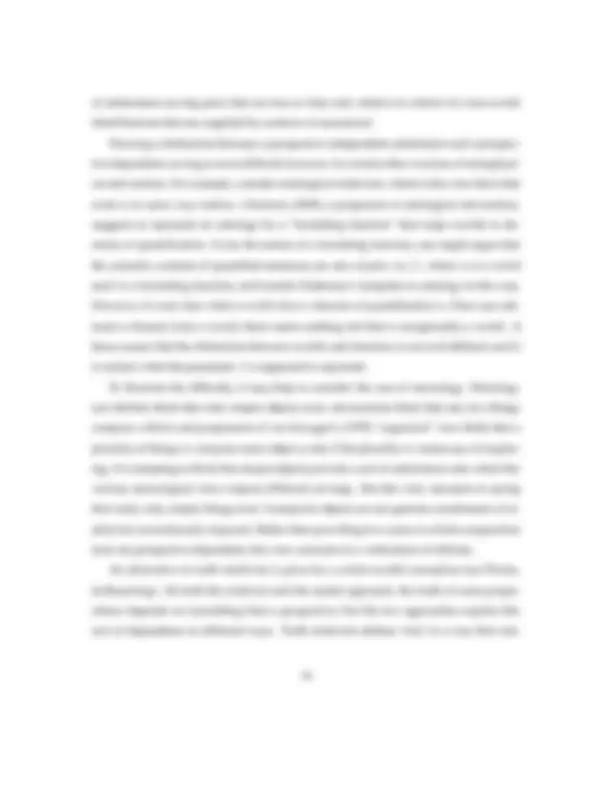
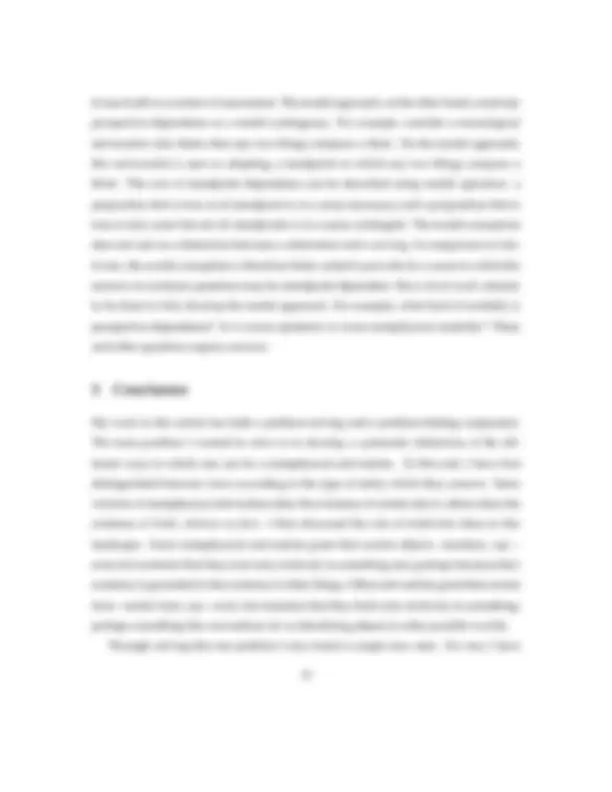
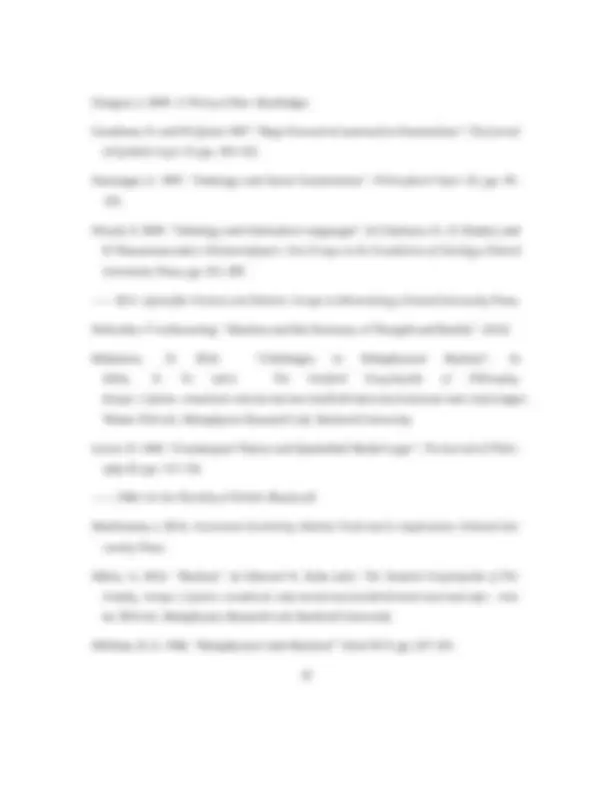
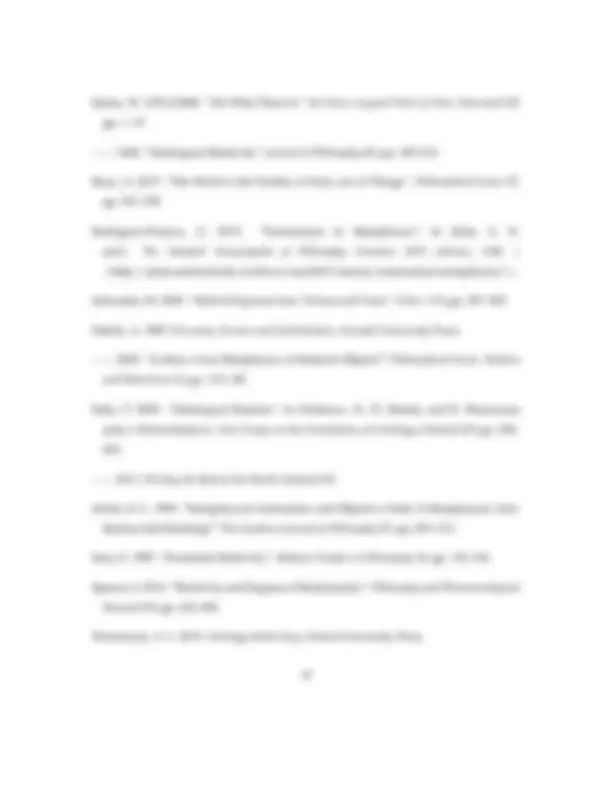



Study with the several resources on Docsity

Earn points by helping other students or get them with a premium plan


Prepare for your exams
Study with the several resources on Docsity

Earn points to download
Earn points by helping other students or get them with a premium plan
Community
Ask the community for help and clear up your study doubts
Discover the best universities in your country according to Docsity users
Free resources
Download our free guides on studying techniques, anxiety management strategies, and thesis advice from Docsity tutors
This in- cludes views according to which certain entities—even though they exist—are not real,
Typology: Slides
1 / 20

This page cannot be seen from the preview
Don't miss anything!













Abstract Metaphysical anti-realism is a large and heterogeneous group of views that do not share a common thesis but only share a certain family resemblance. Views as dif- ferent as mathematical nominalism—the view that numbers do not exist—, ontolog- ical relativism—the view that what exists depends on a perspective—, and modal conventionalism—-the view that modal facts are conventional—all are versions of metaphysical anti-realism. As the latter two examples suggest, relativist ideas play a starring role in many versions of metaphysical anti-realism. But what does it mean for the existence of something to “depend on” a perspective, or for a modal fact to “de- pend on” a convention? We can distinguish between various dependence relations, giving rise to an array of drastically different forms of metaphysical anti-realism. This article offers a guided tour. I develop a systematic distinction between various forms of metaphysical anti-realism with a focus on the role of relativist ideas in this land- scape.
Metaphysical anti-realism is a large and heterogeneous cluster of views that do not share a common thesis but only share a certain family resemblance. Views as different as mathe- matical nominalism^1 —the view that numbers do not exist—, ontological relativism^2 —the ∗I would like to thank the following people for helpful suggestions that influenced my work on this article: Daniel Durante Pereira Alves, Robin Dembroff, Sally Haslanger, Robert Michels, Panu Raatikainen, Agust´ın Rayo, Brad Skow, Jack Spencer, Amie Thomasson and Alessandro Torza. Thanks to David Chalmers for helpful comments on the penultimate version. 1 See Field (1980) for a defense of mathematical nominalism. (^2) See Quine (1968), Davidson (1973/74) and Sosa (1999) for discussions.
view that what exists depends on (something like) a perspective—, and modal conven- tionalism^3 —-the view that modal facts are conventional—all are versions of metaphysical anti-realism. As the latter two examples suggest, relativist ideas play a starring role in many versions of metaphysical anti-realism. But what does it mean for the existence of something to “depend on” a perspective, or for a modal fact to “depend on” a conven- tion? We can distinguish between various dependence relations, giving rise to an array of drastically different forms of metaphysical anti-realism. This article offers a guided tour. I develop a systematic distinction between various forms of metaphysical anti-realism with a focus on the role of relativist ideas in this landscape. I pursue two goals through this discussion. The first goal is to provide a recipe book. Suppose you are inclined towards an anti-realist view with regard to numbers. Which views are available to you? This article distinguishes between a few options. I will not be able to discuss all the options; but I will make a start. The second goal is to increase in- telligibility. Sometimes anti-realist views are phrased in esoteric-sounding terms, as when Sosa (1999, p. 133) says that “In order for [a constituted] sort of entity to exist relative to a conceptual scheme, that conceptual scheme must recognize its constituent form as an appropriate way for a distinctive sort of entity to be constituted.” What is a conceptual scheme, and how can it recognize anything?^4 I won’t answer these questions; but I aim to show that a few versions of metaphysical anti-realism are intelligible and coherent. My discussion will proceed as follows. In §2, I discuss the difference between meta- physical realism and anti-realism. In §3, I discuss the most straightforward versions of metaphysical anti-realism: views according to which certain entities do not exist. In §4, I discuss versions of metaphysical anti-realism that bring in relativist ideas. This in- cludes views according to which certain entities—even though they exist—are not real, (^3) See Sidelle (1989) for a defense of modal conventionalism. (^4) Davidson (1973/74, p. 5) discusses these questions and argues that “Conceptual relativism is a heady and exotic doctrine, or would be if we could make good sense of it. The trouble is, as so often in philosophy, it is hard to improve intelligibility while retaining excitement.”
from other forms of anti-realism. Metaphysical anti-realism is distinguished by its do- main. Other forms of anti-realism include moral anti-realism—the view that moral facts are not absolute—, and aesthetic anti-realism—the view that aesthetic facts are not abso- lute. These other forms of anti-realism also have a metaphysical core, and the distinction between the different versions of anti-realism may not alway be clean-cut. An alternative approach would drop the side-constraint and treat metaphysical anti-realism as the most general form of anti-realism. But that’s not the approach I pursue here. We can distinguish between various versions of metaphysical anti-realism. For one, versions of of metaphysical anti-realism differ with regard to the sort of entities which they concern. Some anti-realist views primarily concern objects; e.g., they may concern the metaphysical status of numbers, of universals, or of composite objects (that have parts), and so on. Other anti-realist views primarily concern facts; e.g., on certain anti- realist views, there is no absolute fact with regard to the existence of numbers. These two approaches—objectual and fact-oriented—are crucially different.^6 For example, arguing that there is no fact of the matter with regard to the existence of numbers appears incon- sistent with arguing that numbers do not exist. Furthermore, versions of metaphysical anti-realism also differ in what they say about the metaphysical status of the entities that they concern. For example, some anti-realists simply deny that Fs exist; other anti-realists allow that Fs exist, but deny that Fs are real (see Fine, 2009). Similarly for anti-realist views about facts. Some anti-realists simply deny the existence of certain facts; others allow that the relevant facts hold, but argue (moreover) that they are not absolute. Given that metaphysical anti-realism is such a broad class of views, most people are anti-realists about some entity or another. For example, most people think that witches and ghosts do not exist; they are anti-realists about witches and ghosts. Saying that some- one is a metaphysical anti-realist without qualification therefore is nearly without content. (^6) A third anti-realist approach is property-oriented. On this approach, certain properties are not genuine constituents of reality. See Spencer (2016) for a relevant discussion of the different ways in which an object can have a property only “relative to” something else.
Metaphysical anti-realism is not the same as metaphysical deflationism. Metaphys- ical deflationists, such as Hirsch (2011) and Thomasson (2015) think that metaphysical inquiry is pointless or misguided. For example, Thomasson (2015) argues that ontolog- ical questions can be answered “easily” and do not require deep, metaphysical inquiry. Deflationist views are often called “anti-realist”, perhaps because deflationists in a sense are “against” metaphysics, and therefore “anti”-metaphysical.^7 But metaphysical anti- realists propose metaphysical views. For example, the thesis that numbers do not exist is a metaphysical thesis about the fundamental structure of reality. There is at least a ten- sion between defending a metaphysical view and arguing that metaphysical inquiry is pointless.^8 It is therefore important to clearly distinguish deflationism from anti-realism.^9 Why this definition of metaphysical anti-realism, and not another? The literature con- tains a range of alternative definitions of ‘metaphysical anti-realism’. Some philosophers think that metaphysical anti-realism equates to idealism (Smith, 1999; Khlentzos, 2016). Other philosophers embrace a disjunctive definition, according to which metaphysical anti-realists either deny that certain entities (Fs, say) exist or else argue that Fs exist mind- dependently (Miller, 2016). Yet other philosophers suggest that, according to anti-realists, certain entities exist but are not “real” (Fine, 2009). A fourth approach construes meta- (^7) For example, Biggs and Wilson (2016) argue that, according to Carnap (1956 [1950]), metaphysical claims are meaningless, and they call this view “metaphysical anti-realism”. 8 Hirsch (2011) combines a deflationary view with the defense of a specific metaphysical viewpoint. To some people, this combination of views has appeared inconsistent. For example, Sider (2011) argues that Hirsch’s view called “quantifier variance” is “just more metaphysics”. 9 Is Hirsch’s (2011) “quantifier variance” view a form of metaphysical anti-realism? Many people think it is, perhaps because of Hirsch’s opposition to Sider’s (2009; 2011) realism about ontology. Hirsch (2009, p. 231) denies, however, that his view is a form of anti-realism: “my position is robustly realist. I take it for granted that the world and the things in it exist for the most part in complete independence of our knowledge or language. Our linguistic choices do not determine what exists, but determine what we are to mean by the words ‘what exists’ and related words”. I think that there is a specific sense in which quantifier variance is an anti-realist view. Hirsch denies that there is a metaphysically distinguished quantificational structure. He is at least an anti-realist about this sort of structure.
tities—views on which numbers, propositions, sets and the like do not exist.^12 The op- ponents of nominalism about universals are realists about universals, and the opponents of nominalism about abstract objects are platonists.^13 Two main kinds of argument sup- port nominalism. First, epistemological arguments. Abstract objects are causally inert, which combined with basic empiricist assumptions may make it seem doubtful that we can have knowledge about them, or know that they exist.^14 Second, indispensability ar- guments. For example, Field (1980) argues that numbers are dispensable for the purposes of science. Since they are dispensable, we have no reason to think they exist. Nominalists deny the existence of certain objects. We can distinguish between differ- ent versions of metaphysical anti-realism with regard to the kind of entities that they con- cern. Other metaphysical anti-realists deny the existence of certain relations, certain kinds, or certain facts, and so on. For example, Wilson (2014) argues that there is no capital- G grounding relation^15 , and Glasgow (2009) denies that race is a biological kind. These views are versions of anti-realism about the capital-G grounding relation and about race as a biological kind, respectively.^16 Furthermore, we can develop views on which facts of a certain sort do not exist in at least two different ways. (^12) To give a few more radical examples, Dasgupta (2009) and Azzouni (2017) both argue that, fundamen- tally, no objects exist at all. On Dasgupta’s (2009) view, the fundamental facts are qualitative and do not concern particular individuals. On Azzouni’s (2017) view, fundamentally only “features” but no objects ex- ist. (^13) See Rodriguez-Pereyra (2015) for a useful overview and references. (^14) Empiricist concerns play a role in Quine’s arguments for nominalism. See Goodman and Quine (1947) and Quine (1953 [1948]). (^15) Wilson (2014) thinks that there are various metaphysical dependence relations, such as type or token identity, functional realization, classical mereological parthood, the set membership relation, the proper sub- set relation, the determinable/determinate relation, and so on, but not a unique in-virtue-of relation that could do all the explanatory work which metaphysicians often want the Grounding relation to do. (^16) Wilson (2014) also supports her view by means of indispensability arguments. She argues that a capital- G grounding relation is not needed to explain anything, and concludes that we should not believe in its existence.
First, according to some meta-ethical expressivists, normative sentences do not ex- press propositions but express non-cognitive mental states. Here is Ayer (1971 [1936], p.
“if I say to someone, ‘You acted wrongly in stealing that money’, I am not stating anything more than if I had simply said, ‘You stole that money’. In adding that this action is wrong I am not making any further statement about it. I am simply evincing my moral disapproval of it.”
Ayer here effectively says that an utterance of ‘stealing is wrong’ expresses moral disap- proval and does not express a proposition. On this view, normative facts do not exist.^17 It is hard to see, however, how one might develop an analogous expressivist view about a metaphysical domain. A possible view is that “numbers exist” does not express a propo- sition but instead expresses approval of numbers; but this view has little going for it.^18 Second, another way for arguing that facts of a certain sort do not exist is by rejecting the principle of bivalence—according to which every proposition is either true or false (but never both)—for a certain area of discourse. Dummett (1982) pursues this approach to anti-realism, and argues that the rejection of bivalence for a particular area of discourse is sufficient for being an anti-realist about that area.^19 For example, one way of being an anti-realist about the past is by rejecting bivalence for statements about the past (see (^17) There are many different versions of meta-ethical expressivism; see Schroeder (2009) for a discussion. On some views, such as Gibbard’s (2003) norm-expressivism, normative sentences do express semantic contents that are very much like propositions but which are true or false only relative to a nonstandard “hyperplan” parameter that represents a norm. (^18) Flocke (forthcoming) develops an expressivist view about ontology. But on Flocke’s view, the semantic values of quantified sentences are propositions. The main difference to a realist view is that these propositions are non-objective. (^19) Fine (2001, p. 6) argues against Dummett that a rejection of bivalence is not sufficient for being an anti- realist. For more detailed discussions of Dummett’s conception of the realism–anti-realism divide, see Edg- ington (1980-81) and Millikan (1986).
anti-realism is quite close to a more “objectual” version of anti-realism that simply denies the existence of certain objects (i.e., numbers).
4 The Role of Relativist Ideas
Proponents of metaphysical anti-realism appeal to relativist ideas in various ways and for a variety of reasons. I will discuss a few examples, first focusing on anti-realist views that concern objects and then focusing on anti-realist views that concern facts. I will discuss two examples of versions of metaphysical anti-realism that concern ob- jects and appeal to relativist ideas. First an example from social metaphysics. Anti-realists about race have reasons to acknowledge the existence of racial groups. Some of these rea- sons are political: a fight against racism makes sense only if race-based discrimination persists, which in turn presupposes the existence of racial groups. But how can an anti- realist about race acknowledge the existence of races? Glasgow (2009) responds to this challenge by arguing that race is not a biological kind but socially constructed. On his view, races understood as biological kinds do not exist, which makes Glasgow an anti-realist about race as a biological kind. But Glasgow never- theless thinks that races exist and are real; they are just socially constructed. In Glasgow’s (2009, p. 5) words: “just as journalists or doctors are real but socially constructed kinds of people, so racial kinds of people are real but socially constructed. Racial groups are real groups that have been created by our social practices, rather than by some biological process.”^21 Glasgow here appeals to social construction as a metaphysical dependence relation in order to explain the nature of races. The upshot is that, since races are not in determining the truth-value of sentences. When this framework is applied to mathematical sentences in particular, it results in a view on which numbers as the referents of mathematical sentences play no role in determining the truth-values of these sentences. (^21) Haslanger (1995) proposes a similar view about gender, according to which genders are socially con- structed but nevertheless exist and are real.
biological kinds but socially constructed, it is “up to us” how to construct them, or to altogether give up on the racial categorizations of people. Now an example from mathematical ontology. Nominalists deny the truth of propo- sitions that may appear obvious and unassailable. For example, five is a number, which trivially entails that numbers exist. Which sort of evidence could possibly override the conclusion of this straightforward argument? Many philosophers think that no evidence could possibly have this effect, which results in a powerful objection to nominalism.^22 One strategy that nominalists may employ in response to this objection is to grant that numbers exist, and to argue that numbers nevertheless are not genuine constituents of re- ality (Fine, 2009). This move gives up the letter of nominalism, but retains the spirit. The distinction between things that are and things that are not real then is often drawn with appeal to broadly relativist ideas. For example, Fine (2001, p. 27) proposes to distinguish between realism and anti-realism as two different views about grounding facts. Ground- ing is a metaphysical dependence relations. If a fact A is grounded in another fact B, then A holds “in virtue of” B; B provides a metaphysical explanation for A. Fine proposes that, if the existence of numbers is grounded in other facts, then numbers are not genuine constituents of reality, since only ungrounded facts are genuine constituents of reality.^23 I will now turn to views on which certain facts—even though they exist—hold only relatively to something else. For example, Lewis (1968, p. 122) argues that an object’s essential property is the property it shares with all its counterparts, and Lewis (1986, p.
taste the answer is obvious: the new parameter is a standard of taste. But what about other sorts of metaphysical relativism, such as perhaps relativism about modal facts?^24 Einheuser (2006) develops a generic template that can help metaphysical anti-realists to answer this question. Einheuser suggests that each world is composed of a perspective independent substratum and a perspective dependent carving. One of the substrata is the unique actual substratum. The actual substratum is compatible, however, with several carvings—none of which is uniquely actual. The semantic values of declarative sentences are not ordinary propositions but sets of pairs 〈s, c〉, where s is a substratum and c a carving. Suppose now that the actual substratum s@ is compatible with two carvings, c 1 and c 2. A set A of ordered pairs 〈s, c〉 may be such that 〈s@, c 1 〉 ∈ A but 〈s@, c 2 〉 ∈/ A. In that case, A is true at 〈s@, c 1 〉 but false at 〈s@, c 2 〉. Next, one just needs to define ‘true’ as a two-place predicate that applies to semantic contents only relative to contexts of assessment; in such a way that A is true relative to contexts of assessments that supply carving c 1 and false relative to contexts of assessment that supply carving c 2. To make use of Einheuser’s template, metaphysical relativists have to explain which sorts of entities make up the substratum, and how one may impose a carving on a substra- tum. Some versions of metaphysical anti-realism have a straightforward explanation.^25 Consider, for instance, Sidelle’s (2002) modal conventionalism. We can explicitly de- velop this view as a form of relativism by arguing that non-modal facts provide a sort of perspective-independent substratum onto which conventions for cross-world identifi- cations then impose a perspective-dependent modal structure. One may then argue that the semantic values of sentences concerning what’s possible and what’s necessary are set (^24) Sidelle (2002) argues that modal facts depend on conventions, which is a view that could be spelled out as a form of relativism about modal facts. 25 Gibbard’s (2003) norm-expressivism applies Einheuser’s template in a very intuitive manner. In Gibbard’s view, the semantic values of declarative sentences are sets of pairs 〈w, p〉, where w is a possible world and p is a hyperplan. A hyperplan is a function that represents a norm, and that maps each occasion for action in a world to a set of actions that are permitted on that occasion. On this view, norm-normative or descriptive facts, represented by possible worlds, provide a sort of perspective-independent substratum, and norms, represented by hyperplans, impose carvings onto worlds.
of substratum-carving pairs that are true or false only relative to criteria for cross-world identifications that are supplied by contexts of assessment. Drawing a distinction between a perspective independent substratum and a perspec- tive dependent carving is more difficult, however, for certain other versions of metaphysi- cal anti-realism. For example, consider ontological relativism, which is the view that what exists is in some way relative. Chalmers (2009), a proponent of ontological anti-realism, suggests to represent an ontology by a “furnishing function” that maps worlds to do- mains of quantification. Given the notion of a furnishing function, one might argue that the semantic contents of quantified sentences are sets of pairs 〈w, f 〉, where w is a world and f is a furnishing function, and transfer Einheuser’s template to ontology in this way. However, it is not clear what a world minus a domain of quantification is. Once one sub- tracts a domain from a world, there seems nothing left that is recognizably a world. It hence seems that the distinction between worlds and domains is not well-defined, and it is unclear what the parameter f is supposed to represent. To illustrate the difficulty, it may help to consider the case of mereology. Mereolog- ical nihilists think that only simple objects exist, universalists think that any two things compose a third, and proponents of van Inwagen’s (1995) “organicist” view think that a plurality of things xx compose some object y only if the plurality xx makes up a living be- ing. It is tempting to think that simple objects provide a sort of substratum onto which the various mereological views impose different carvings. But this view amounts to saying that really only simple things exist. Composite objects are not genuine constituents of re- ality but conventionally imposed. Rather then providing for a sense in which composition facts are perspective-dependent, this view amounts to a vindication of nihilism. An alternative to truth relativism is given by a certain modal conception (see Flocke, forthcoming). On both the relativist and the modal approach, the truth of some propo- sitions depends on (something like) a perspective; but the two approaches explain this sort of dependence in different ways. Truth relativists defines ‘true’ in a way that rela-
merely distinguished between various ways of being an anti-realist. But the various ap- proaches need not be equally good! One important question for future research con- cerns an evaluation of the comparative advantages and disadvantages of the various approaches. Second, I have merely sketched the different approaches to anti-realism at a very high level of abstraction. Another important line of future inquiry concerns the details. Consider, for instance, the view that mathematical propositions have a merely relative truth-value. How could you spell out the details of this view?
References
Ayer, A. 1971 [1936]: Language, Truth and Logic. Penguin Books.
Azzouni, J. 2017: Ontology without Borders. Oxford University Press.
Biggs, S. and J. Wilson 2016: “Carnap, the Necessary A Posteriori, and Metaphysical Anti- Realism”. In Blatti, S. and S. Lapointe (eds.): Ontology after Carnap, Oxford University Press.
Brigandt, I. and A. Love 2017: “Reductionism in Biology”. In Zalta, E. N. (ed.): The Stanford Encyclopedia of Philosophy (Spring 2017 Edition), URL = https://plato.stanford.edu/archives/spr2017/entries/reduction-biology/.
Carnap, R. 1950: Logical Foundations of Probability. University of Chicago Press.
—— 1956 [1950]: “Empiricism, Semantics, and Ontology”. In Meaning and Necessity, The University of Chicago Press, pp. 205–221.
Chalmers, D. 2009: “Ontological Anti-Realism”. In Chalmers, D. J., D. Manley and R. Wasserman (eds.): Metametaphysics. New Essays on the Foundations of Ontology, Ox- ford University Press, pp. 77–129.
—— forthcoming: “Idealism and the Mind-Body Problem”. In Seager, W. (ed.): The Rout- ledge Handbook of Panpsychism, Routledge.
Dasgupta, S. 2009: “Individuals: An Essay in Revisionary Metaphysics”. Philosophical Studies 145, pp. 35–67.
Davidson, D. 1973/74: “On the Very Idea of a Conceptual Scheme”. Proceedings and Ad- dresses of the American Philosophical Association 47, pp. 5–20.
Dummett, M. 1968–1969: “The Reality of the Past”. Proceedings of the Aristotelian Society 69, pp. 239–258.
—— 1977: Elements of Intuitionism. Oxford University Press.
—— 1982: “Realism”. Synthese 52, pp. 55–112.
Edgington, D. 1980-81: “Meaning, Bivalence and Realism”. Proceedings of the Aristotelian Society 81, pp. 153–173.
Einheuser, I. 2006: “Counterconventional Conditionals”. Philosophical Studies 127, pp. 459–
Field, H. 1980: Science without Numbers. Princeton University Press.
Fine, K. 2001: “The Question of Realism”. Philosophers’ Imprint 1, pp. 1–30.
—— 2009: “The Question of Ontology”. In Chalmers, D., R. Wasserman and D. Manley (eds.): Metametaphysics. New Essays on the Foundations of Ontology, Oxford University Press, pp. 156–177.
Flocke, V. forthcoming: “Ontological Expressivism”. In Miller, J. (ed.): The Language of Ontology, Oxford University Press.
Gibbard, A. 2003: Thinking How to Live. Harvard University Press.
Quine, W. 1953 [1948]: “On What There Is”. In From a Logical Point of View, Harvard UP, pp. 1–19.
—— 1968: “Ontological Relativity”. Journal of Philosophy 65, pp. 185–212.
Rayo, A. 2017: “The World is the Totality of Facts, not of Things”. Philosophical Issues 27, pp. 251–278.
Rodriguez-Pereyra, G. 2015: “Nominalism in Metaphysics”. In Zalta, E. N. (ed.): The Stanford Encyclopedia of Philosophy (Summer 2015 edition), URL = http://plato.stanford.edu/archives/sum2015/entries/nominalism-metaphysics/.
Schroeder, M. 2009: “Hybrid Expressivism: Virtues and Vices”. Ethics 119, pp. 257–309.
Sidelle, A. 1989: Necessity, Essence and Individuation. Cornell University Press.
—— 2002: “Is there a true Metaphysics of Material Objects?” Philosophical Issues: Realism and Relativism 12, pp. 118–145.
Sider, T. 2009: “Ontological Realism”. In Chalmers, D., D. Manley and R. Wasserman (eds.): Metametaphysics. New Essays on the Foundations of Ontology, Oxford UP, pp. 384–
—— 2011: Writing the Book of the World. Oxford UP.
Smith, D. C. 1999: “Metaphysical Anitrealism and Objective Truth: It Metaphysical Anti- Realism Self-Refuting?” The Southern Journal of Philosophy 37, pp. 293–313.
Sosa, E. 1999: “Existential Relativity”. Midwest Studies in Philosophy 23, pp. 132–143.
Spencer, J. 2016: “Relativity and Degrees of Relationality”. Philosophy and Phenomenological Research 92, pp. 432–459.
Thomasson, A. L. 2015: Ontology Made Easy. Oxford University Press.
van Inwagen, P. 1995: Material Beings. Cornell University Press.
Wilson, J. 2014: “No Work for a Theory of Grounding”. Inquiry 57, pp. 535–579.